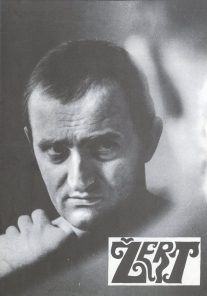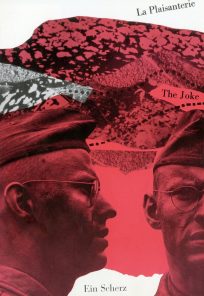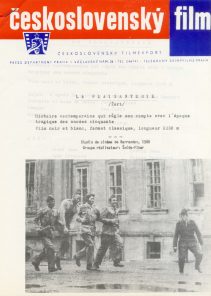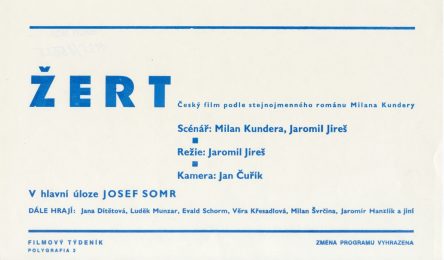In art film, the 1960s will always be associated with the emergence of new waves and the second and final rise of modernism, which first appeared in cinematography in the 1920s in the form of various avant-garde styles and reappeared two decades later with Italian neorealism. While in the era of silent film directors looked for ways to make the film expression unique by working with the editing rhythm and various optical modifications of images, after the Second World War the public began to accept films as an autonomous art form, so the previously suppressed theatricality could return. Instead of music and fine art, filmmakers started drawing inspiration from theatre and literature[1] and used dialogues and stories to attract bigger audiences than they would with non-narrative and experimental films.
Literature also strongly influenced Czechoslovak modernist film, or rather the Czechoslovak New Wave – let us name the renowned duos Hrabal-Menzel, Körner-Vláčil, and Procházka-Kachyňa. A potential snag in adapting a literary work is generally the filmmaker’s tendency to transfer scenes from the book to the silver screen word for word without enriching the adapted material. Such an approach may be motivated by a fear of the reaction of fans of the original, who often perceive any changes as a betrayal and have their own clear visions. On the other hand, modernism in film is characterised by using original formal methods, and literature offered many topics whose mere existence was an extraordinary phenomenon within socialist Czechoslovakia. Their adaptations represented the extension of a gesture of going against the requirements of officially dictated culture. Sometimes, such explication could even outweigh other forms of interpretation. Director Jaromil Jireš also adapted several literary works – two of these films still rank among his best work.
Blazon Films of 1960s
There are not many culturally educated Czechs who don’t know Milan Kundera’s The Joke (Žert) – at least by name – whether in its literary (1967) or film (1968) form. The novel built around the writer’s favourite theme of interpersonal relations / romances tells the story of an ideological transition of a former active member of the Communist party and his subsequent quest for vengeance on Pavel, the culprit of the wrongs the main hero had to suffer. When the novel was first published, it signalled a change of the political climate, an opportunity to explore themes that were previously taboo. A year later, the second edition of Ludvík Vaculík’s Axe (Sekyra, 1966) appeared in bookstores. It explored a similar theme from a different perspective. Both novels have since attained the status of blazon books of the 1960s[2]. This was mainly due to the social rather than artistic bravery of the authors (but I don’t intend to cast doubt on either) that both novels were banned in the 1970s during the period of “Normalization”.
A comparable social significance and status can be attributed to the film adaptation of Kundera’s The Joke made by Jaromil Jireš in 1968 as his second feature film. “Compared to parables like A Report on the Party and its Guests (O slavnosti a hostech, 1965, dir. Jan Němec) and Seventh Day, Eighth Night (Den sedmý, osmá noc, 1969, dir. Evald Schorm), The Joke is probably the most open and historically precise criticism of the totalitarian Communist ideology,”[3] writes film historian Jan Lukeš. Taking a closer look, we find out that the rooted categorization of The Joke as a political book was adopted from the time of its writing, and it proves the necessity of a moral compass in tough times. But when we apply it to the film, as discussed in the following paragraphs, it is a considerable simplification. It doesn’t consider the genesis of the film and its context (even though politics naturally cannot be omitted) or its character of an adaptation of a popular novel.
The script was done already in December 1966, a year after the novel was finished and several months before it was published. The book was adapted by Kundera himself in collaboration with Jireš, who was at that time carefully looking for a theme for his new film. Critics[4] received his debut film The Cry (Křik, 1963) positively as a successful modern (“feeling”) film, but at the same time, it was officially praised as an example worth following, and the director wanted to avoid that in the future.[5] And that meant a long wait filled with a fruitless effort to push through several projects and making short documentary films.[6] Jireš was eventually allowed to start filming The Joke five years after the premiere of The Cry. By that time, he no longer felt the pressing need to adapt a story that, according to him, has lost its topicality and would rather have moved on to more personal themes.[7] His inclination towards subjective and poetic films, as evident already in The Cry, can be perceived as a thought-provoking impulse and the basis of an analysis of The Joke from a new perspective. There is no need to explain how the tragic events of August 1968 made The Joke topical again and laid the basis for its subsequent reflections.
The questionability of The Joke as a literary adaptation lies within its approach to the novel’s plot, which Kundera and Jireš trimmed down significantly.[8] For Bohemist and literary historian Tomáš Kubíček, the film has fewer layers and is therefore less interesting.[9] In relation to the novel, its story is merely illustrative. What are the concrete differences? First of all, there is no Lucie in the film, Ludvík’s sweetheart from the times of his military service, who in the novel acts as a psychological support during the protagonist’s transformation from an avid Communist to a cynic. Ludvík’s religious friend Kostka also wasn’t given much space in the film, and the storyline following violinist Jaroslav looking forward to his son’s participation in the folk tradition of the Ride of the Kings is missing entirely. The event becomes a mere setting for the film’s final act. There were probably two main motivations for these modifications. They aimed to shorten the story and tone down some motifs that could potentially cause trouble in the film’s approval process (erotic, religious)[10]. It’s not clear whether this included leaving out Ludvík’s political transformation, which was so important in the novel.
Subjective World of the Hero and the Body as an Instrument of Vengeance
“Jireš is a master of montage and I consider his The Joke to be mine. And by that, I mean that I like everything he introduced to my novel. (…) It’s rare when a novelist can pay tribute to a director who has adapted his book without any reservations. I don’t want to miss the opportunity to do that,”[11] said Kundera about the film version of The Joke in the early 1990s. The important thing is that he praised the film’s editing, which plays a significant role in its style and is simultaneously an exclusively cinematographic means of expression.[12] It can therefore help us to move from a comparison between the novel and the film to its analysis as an autonomous work of art. Sharp editing connects not only two timelines in which the novel is set, but also various perspectives from which we see the story. Four pairs of eyes are replaced by just one pair – Ludvík’s. That removes a problem so often thematised by modern art – the impossibility of recording the objective truth – and shifts to an equally discussed complementary issue – how to present the subjective world of the main hero to viewers?
The Joke is divided into two halves, both of which begin with the same scene of a bus arriving at a square. The first half is mainly retrospective. Through Ludvík’s memories, it reveals his motivation for revenge taking place in the second act and is therefore set mainly in his mind. We can identify some subjectivisation techniques (whether intended or not) in the omission of the exhaustively described circumstances from the book, unfinished sentences and “nervous” abrupt cuts disrupting for instance the flow of the scene with Markéta near the Vltava River. The montage of these scenes can be interpreted as a diagnosis of Ludvík’s current state of mind, aggravated by the notion of revenge, but at the same time as a symbolical portrayal of the past, which is “still with us” and influences us. The camera technique of shot and reverse shot shows Ludvík simultaneously in a hotel room and at a “people’s court” in a Faculty of Arts lecture hall. This amalgamation of two scenes and soundtracks creates meanings outside the framework of the film’s fictional world, just like when Jireš creates a humorous contrast by connecting the scenes taking place at the aforementioned court with scenes taking place during the “Welcoming of Newborns” ceremony, where the director puts the words of one of Ludvík’s judges into the mouth of a civil servant.
That moment is not just about realising how various collective rituals in totalitarian systems control and govern the lives of individuals, but that they’re also an update of older traditions (The “Welcoming of Newborns” as a profane socialist alternative of christening)[13] whose power and influence in the modern world declines rapidly. They lose their significance and become a mere background to other activities such as the Ride of the Kings in this film. The Joke uses the character of Pavel’s estranged wife, Helena, to point out the shallow relationships of the members of the Youth Movement to popular culture and culture in general, but at the same it reveals what motivates and drives human society. Unsurprisingly enough, it’s one of the basic needs – sexual instinct. The infamous letter about optimism and Trotsky which initiates the whole tragedy was written by Ludvík when frustrated by a romantic failure. His revenge on Pavel includes seducing Helena. The next day, when Ludvík meets Pavel, he finds out that his plan has failed. He learns that Pavel’s marriage has for some time now been only formal, and he is introduced to Pavel’s younger and sexually more attractive lover. The human body as an instrument of vengeance in the scene of “retaliation” is emphasised by focal shots and the dramatic stylisation of Josef Somr and Jana Dítětová in leading roles.
At the time of its premiere[14], Czechoslovak critics frequently reflected The Joke as an attempt to come to terms with the past and pointed out the limitations of such efforts. But no one questioned Ludvík’s right to vengeance and the way he decided to obtain it. They attached much more importance to the social and moral value of the film, which was put alongside other thematically daring films such as The End of a Priest (Farářův konec, 1968) and Case for the New Hangman (Případ pro začínajícího kata, 1969).[15] The critics directed their attention towards values imbued in the film by the contemporary social situation; they found it important to condemn the behaviour of an opportunistic Pavel. They didn’t comment on the omission of the of book’s political undertones. It wasn’t until 1991 and the film’s return to cinemas when Pavlína Kubíková mentioned the omitted political layer[16] and Jan Jaroš rightfully described Ludvík’s behaviour as cowardly and unworthy of following.[17] But the topicality of Pavel’s character perhaps surprisingly remained: “with his behaviour, the character of the hero’s main enemy reminds of today’s attitudes of similar officials and once again proves that such people are incapable of change.”[18]
Aesthetically Independent Valerie
While The Joke, despite Jireš’s expectations, was made at the right moment and became one of the canonical films of the New Wave, his third film, Valerie and Her Week of Wonders (Valerie a týden divů, 1970), based on a novel of the same name by Vítězslav Nezval made not long after The Joke, isn’t paid a lot of attention. At least not in the Czech Republic. There were several DVD and Blu-ray[19] versions published abroad, and the film is often mentioned as the director’s most important work alongside The Joke.
Trying to describe the plot of either the film or the literary version of Valerie and Her Week of Wonders is utterly futile: “it’s like a dream that may not have happened at all.”[20] Suffice it to say that the story revolves around the 13-year-old titular heroine, who has just crossed the threshold of adulthood and is experiencing a magical week. She meets young Orlík, who would like to become her lover but can also be her long-lost brother, and other significantly more dangerous characters: the lustful priest Gracián; the archvillain Tchoř, who can change his shape; and Valerie’s own grandmother. The film makes a rather consistent use of a dreamy logic, so each viewer/reader must discover for themselves who is who or what “actually” happened (if it happened at all). Those who haven’t read the novella will be surprised that the film is a rather literal/illustrative adaptation of the original, which is so economical that it didn’t have to be (significantly) shortened. Jireš wrote the script together with Ester Krumbachová and toned down some motifs.[21] But what’s important is that together they turned the text into a perfect film.
Naturally, we can’t forget the essence of the material. Nezval, a member of the Děvetsil Union of Modern Culture, had a penchant for film, just like other avant-garde writers in 1920s, and he even worked on several film scripts [22] and was familiar with a visual style of thinking. In graphic artist and costume designer Ester Krumbachová, his work found an ideal “intermedia interpreter”, and with its stylisation, it ranks among the best imaginative films of the New Wave.[23] The strength of these films lies in their imaginative approach to the scene composition and mise-en-scène as well as the technical aspects, such as editing. Unlike The Joke, the montage in Valerie doesn’t compare, look for parallels or conform to the purpose of telling a comprehensible story, but uses many poetic digressions to set the mood and take viewers into a dream state with their eyes open. The authors achieve the coveted effect through deliberately sharp colour and sound transformations between scenes and various “peculiarities” to which the characters don’t pay any attention (for instance, the letter by Orlík is written in rainbow capitals). As Russian director Alexander Sokurov puts it, the film stakes a claim for aesthetic independence.[24]
It’s a rebellion against the dictate of style or the aesthetics prescribed by the totalitarian regime, a phenomenon which David Bordwell uses to explain the origins of “poetic film” within the politically-critical movement.[25] It’s no coincidence that the manifestations of this phenomenon can be traced to the countries of the Eastern Bloc (with the exception of Italy).[26] The 1960s were an ideal time for it, not only for social and political reasons, but also for technological reasons – the film format started widening, colour film became more accessible, and the colours themselves were richer than ever. The “dance” scene of coloured figures against a black background in Vojtěch Jasný’s The Cassandra Cat (Až přijde kocour, 1963), filmed in an extremely wide format (with aspect ratio 1:2.35), can be labelled as the initiation scene of this style. But some gymnastic training scenes from Something Different (O něčem jiném, 1963), which is traditionally associated with the opposite trend of combining live action with documentary, can also be seen as abstract fine art. With Valerie and Her Week of Wonders, which demonstrated its independence by rejecting genre conventions, daringly portraying eroticism and a general distrust of institutions (religious and family), imaginativeness leaves Czechoslovak cinema. It reappears occasionally in fantastic films but doesn’t return until the late 1980s with films such as The Prague Five (Pražská pětka, 1988) and Pilgrims (Poutníci, 1988).
There and Back Again
The comparison of The Joke and Valerie and their literary versions results in several remarkable observations. We can see how modernism in film drew inspiration from literary sources, but also how it returned from realism back to imaginativeness. It also shows how a film can breathe new life into an accurately (or perhaps word-for-word) adapted screenplay and how strongly its perception is influenced by social circumstances. A political aspect has always been and will always remain significant for any work of art born in a society lacking freedom. And what lessons taken from the two films are still valid to this day? If The Joke’s story is not just about revenge but also about an effort to come to terms with the past, it’s point ironically adds that something like that is impossible. We must learn how to work with the past – that’s where the timeless value of Kundera’s work lies. And if we want to perceive Valerie and Her Week of Wonders as a surreal variation of a fairy-tale, there’s a very distinct lesson to be learned: whatever it takes, do not trust the authorities!
Jan Bergl
Notes:
[1] András Bálint Kovács, Screening Modernism: European Art Cinema, 1950-1980. The University of Chicago Press 2007, p. 53.
[2] Jan Lukeš, Orgie střídmosti aneb Konec československé státní kinematografie: (kritický deník 1987–1993). Prague: Národní filmový archiv 1993, p. 167.
[3] Jan Lukeš, Žert. Iluminace 8, 1996, no. 1, p. 164.
[4] Lukáš Skupa, Moderní, nebo jen módní? Reflexe počátků „nové vlny“ v Československu. Cinepur 21, 2014, no. 91, p. 59.
[5] Antonín J. Liehm and Jan Lukeš, Ostře sledované filmy: československá zkušenost. Prague: Národní filmový archiv 2001, p. 246.
[6] One of them, The King Game (Hra na krále, 1967), is often mentioned as Jireš’s preparation for Joke. But apart from the motif of folklore tradition, these two films haven’t got much in common.
[7] Antonín J. Liehm and Jan Lukeš, Ostře sledované filmy: československá zkušenost. Prague: Národní filmový archiv 2001, p. 249.
[8] According to an article published in Iluminace, the changes were made mainly by Kundera. In: Milan Kundera, Můj přítel Jireš. Iluminace 8, 1996, no. 1, p. 6.
[9] Tomáš Pancíř, České knihy, které musíte znát. Available online at: https://cesky.radio.cz/ceske-knihy-ktere-musite-znat-8508847/18 [published: 11th November 2020; quoted 28th February 2021]
[10] As referred to in an article in Filmový přehled, 1969, no. 2.
[11] Milan Kundera, Můj přítel Jireš. Iluminace 8, 1996, no. 1, p. 6.
[12] The Joke was edited by exceptional Czech editor Josef Valušiak who collaborated with Jireš on his other films. He also worked with e.g. Karel Zeman, Jiří Svoboda and Miloš Zábranský.
[13] see Jiří Cieslar, Žert. Reflex 16, 2005, no. 27, pp. 64–67.
[14] In the theatres from 28th February 1969.
[15] Ludvík Pacovský, Třikrát Žert. Kino 24, 1969, no. 2, p. 2.
[16] Pavlína Kubíková, Žert. Záběr 23, 1990, no. 24, p. 6
[17] Jan Jaroš, Odvrácená tvář žertování. Scéna 15, 1990, no. 17, p. 6
[18] Žert, Filmový přehled, 1990, no. 8, p. 46.
[19] By prestigious publishers Criterion Collection and Second Run.
[20] Cinema 6, 1996, no. 10, p. 91.
[21] Peter Hames, Československá nová vlna. Prague: Levné knihy 2008, p. 226.
[22] For example From Saturday to Sunday (Ze soboty na neděli, 1931) by Gustav Machatý.
[23] For example Daisies (Sedmikrásky, 1966), Fruit of Paradise (Ovoce stromů rajských jíme, 1969), Killing the Devil (Vražda Ing. Čerta,1970)
[24] Sokurov mentions it in the documentary The Vocice of Sokurov (2014).
[25] David Bordwell, Kristin Thompson, Dějiny filmu (Film History, An Introduction). Praha: AMU: NLN, 2011, p. 575.
[26] András Bálint Kovács, Screening Modernism: European Art Cinema, 1950–1980. The University of Chicago Press 2007, p. 182.




